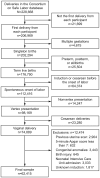Contemporary patterns of spontaneous labor with normal neonatal outcomes
- PMID: 21099592
- PMCID: PMC3660040
- DOI: 10.1097/AOG.0b013e3181fdef6e
Contemporary patterns of spontaneous labor with normal neonatal outcomes
Abstract
Objective: To use contemporary labor data to examine the labor patterns in a large, modern obstetric population in the United States.
Methods: Data were from the Consortium on Safe Labor, a multicenter retrospective study that abstracted detailed labor and delivery information from electronic medical records in 19 hospitals across the United States. A total of 62,415 parturients were selected who had a singleton term gestation, spontaneous onset of labor, vertex presentation, vaginal delivery, and a normal perinatal outcome. A repeated-measures analysis was used to construct average labor curves by parity. An interval-censored regression was used to estimate duration of labor, stratified by cervical dilation at admission and centimeter by centimeter.
Results: Labor may take more than 6 hours to progress from 4 to 5 cm and more than 3 hours to progress from 5 to 6 cm of dilation. Nulliparous and multiparous women appeared to progress at a similar pace before 6 cm. However, after 6 cm, labor accelerated much faster in multiparous than in nulliparous women. The 95 percentiles of the second stage of labor in nulliparous women with and without epidural analgesia were 3.6 and 2.8 hours, respectively. A partogram for nulliparous women is proposed.
Conclusion: In a large, contemporary population, the rate of cervical dilation accelerated after 6 cm, and progress from 4 cm to 6 cm was far slower than previously described. Allowing labor to continue for a longer period before 6 cm of cervical dilation may reduce the rate of intrapartum and subsequent repeat cesarean deliveries in the United States.
Figures




Comment in
-
Zhang's guideline to assess labour progression.Lancet. 2019 Jan 26;393(10169):300-301. doi: 10.1016/S0140-6736(18)32274-8. Epub 2018 Dec 20. Lancet. 2019. PMID: 30581040 No abstract available.
References
-
- Friedman EA. The graphic analysis of labor. Am J Obstet Gynecol. 1954;68:1568–75. - PubMed
-
- Friedman EA. Primigravid labor: a graphicostatistical analysis. Obstet Gynecol. 1955;6:567–89. - PubMed
-
- Friedman EA. Labor: Clinical Evaluation and Management. 2nd. New York: Appleton-Century-Crofts; 1978.
-
- Zhang J, Troendle J, Yancey MK. Reassessing the labor curve in nulliparous women. Am J Obstet Gynecol. 2002;187:824–8. - PubMed
-
- Zhang J, Troendle J, Reddy U, Laughon SK, Branch DW, Burkman R, Landy HJ, Hibbard JU, Haberman S, Ramirez MM, Bailit JL, Hoffman MK, Gregory KD, Gonzalez-Quintero VH, Kominiarek M, Learman LA, Hatjis CG, Van Veldhuisen P. Contemporary cesarean delivery practice in the United States. Am J Obstet Gynecol (in press) - PMC - PubMed
Publication types
MeSH terms
Grants and funding
LinkOut - more resources
Full Text Sources
Medical

